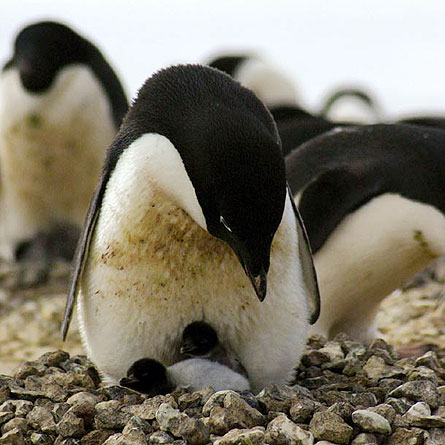- More than 2 years ago
The evolutionary march of the penguins happened in double time, according to new genetic calculations.

A study of DNA from ancient and modern Adélie penguins suggests that scientists may have miscalculated the rates at which genetic clocks tick off evolutionary time in other species as well. A team of researchers collected mitochondrial DNA from penguins currently living in rookeries in Antarctica and from bones of penguins that had lived in the same spot as long as 44,000 years ago. Analysis of the DNA reveals that the penguins are evolving on a molecular scale two to six times faster than standard calculations indicated, the team reports in the November Trends in Genetics.
Mitochondria are small structures that generate power inside cells. The organelles were once free-living bacteria and have kept their own circle of DNA, which encodes many of the proteins needed for power production. The function of mitochondria is so crucial to the cell that any changes to mitochondrial genes are likely to throw a wrench into a cell’s energy-generating capabilities. As a result, the mitochondrial DNA has evolved slowly. Scientists can use the number of changes in mitochondrial DNA between different species to calculate a molecular rate of evolution and estimate how long ago the species shared a common ancestor.
One of the most basic assumptions is that the rate of evolution is the same in all species, says Stephan Schuster, a genomicist at Pennsylvania State University in State College. But some scientists have begun questioning that assumption. Now, the new study provides evidence that, at least for Adélie penguins, evolution is happening faster than previously thought.
“This is a beautiful study,” says Schuster, who was not involved in the work. “Some people have been saying this for a long time, but no one has shown this in such a systematic way.”
Most calculations of the rate of evolution are based upon changes in a part of the mitochondrial DNA called the hypervariable region, where change happens at a relatively fast pace. The new study decoded the entire mitochondrial genome, not just the hypervariable region, and compared the rate of change among penguin generations for all parts of the DNA circle.
Usually, ancient DNA is badly degraded, but because Antarctica is so cold, specimens were well preserved. The team was able to extract DNA from several penguin generations, including 12 modern penguins and eight ancient penguins that ranged from 250 to 44,000 years old.
Using the ancient DNA allowed the researchers to track all of the changes in the mitochondrial genome, a process that is normally invisible when scientists compare DNA between two modern species, says Dee Denver, an evolutionary geneticist at Oregon State University in Corvallis and a coauthor of the study. Each difference in the DNA between two species is calculated as a single change when, in fact, multiple changes might have happened. The team was able to see all of these steps by comparing the modern birds to several generations of their ancestors.
Overall, the whole mitochondrial genome was experiencing more changes per unit time than previous methods had predicted. But each part of the circular mitochondrial genome evolves at different rates, the team found. Protein-coding genes change more slowly than the hypervariable region, and genes that encode transfer RNAs and ribosomal RNAs change even more slowly than protein coding regions. These data indicate that scientists should calculate evolutionary rates on the basis of the entire mitochondrial genome, not just a small part, Denver says.
Using only the hypervariable region might also throw off estimates of human migrations as well as broader evolutionary time scales, he says. And each species may have its own rate that can’t be generalized to other species, even if closely related. “When you’re extrapolating these rates to another group, there’s a very good chance it’s an underestimate,” Denver says.






